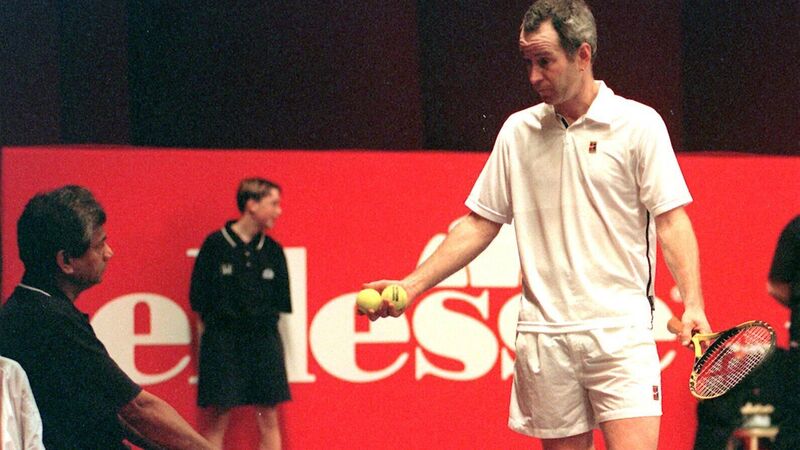Paul Rouse: Rise of the machines - cutting edge technology is transforming sport

YOU GOTTA BE KIDDIN' ME: John McEnroe questions the call of a line-judge while playing in an exhibition match in London. This week, the USTA announced that line judges will no longer be used at the US Open. Picture: Toby Melville/PA
This week brought another step in the rapid transformation of sport through technological change.
The United States Tennis Association (USTA) announced that line judges will no longer be used at the US Open.
Instead, electronic line-calling technology will be used on every court during 2021’s final Grand Slam event.
Last year, electronic line calling technology was used in some courts and was also used at the Australian Open. It is a move that was largely welcomed by players.
Indeed, the USTA went even further and announced that seven of the nine major tennis tournaments on the American leg of the world tennis tour will use the technology on all courts this year.
Last year, in the two tournaments where electronic line-calling was used, the ‘Hawk-Eye Live’ technology made some 314,000 calls — and made them accurately.
The cost to this accuracy is the loss of that drama of spectacular outbursts of aggrieved players who will now be deprived of the opportunity to throw a tantrum in disgust at line judges and match umpires.
But what is happening in tennis is merely indicative of what is underway across the sporting world. Ultimately, this is change that should lead to better officiating in every sport. For example, a sport such as boxing is clearly ripe for more accurate judging.
Changes to officiating is only one aspect of technological change that will matter in the coming years.
The impact of artificial intelligence (AI) is likely to be immense. Advances in computer power and in the gathering and usage of data, with the possibilities for enhanced cognitive abilities in machines, will undoubtedly change many aspects of sport.
It will obviously impact on the business of sport in the manner in which it will allow for unprecedented insight into consumer behaviour and personalised marketing. The more significant question is the extent to which AI will be applied to sporting performance.
One of the great challenges in sport is how to use information, how to sift through evidence, prioritise that which is considered most relevant and use this as an aid to enhance performance.
The logic of AI is that it should allow an increasingly information-based approach to such matters as pre-and post-match analysis of both teams and their opponents. For example, AI — properly harnessed — will help teams understand patterns of play used by their opponents.
And in terms of preparing players, workouts will increasingly be personalised and managed through realtime information feedback to improve both technique and efficacy of effort. The bottom line in all of this is not just accuracy of information, but also accuracy of analysis and accuracy of application.
The great unknowable is the extent to which AI will play against the undeniable emotional aspect of sport. Will human behaviour be so fundamentally changed by AI that emotional actions and reactions will be overwhelmed? And even if not overwhelmed, to what extent will they be tempered?
It will be fascinating to watch how this unfolds; emotion is fundamental to the meaning of sport, to the connections between participant and spectator, to the drama that unfolds. Any significant loss of emotion will diminish the experience and the spectacle.
What seems clear, however, is that in terms of the impact of the internet, we are only at the beginning of the change that it is bringing to how sport is organised. What is also clear is that the internet is doing much more than changing how the world engages with traditional sports. It has also nurtured a whole new sphere of sporting activity.
The great transformation of the new millennium is the growth of eSports — short for electronic sports. A huge variety of such games exist, including League of Legends, Mortal Kombat, FIFA, Overwatch, Heroes of the Storm, Fortnite, NBA2K20, and Call of Duty, falling into the broad categories of strategy games, shooters, and sport and race simulations.
By 2017, video gameplay was the leading consumer-entertainment industry in the world — larger than both the film and music industries. This vast hinterland of amateur players is the mass from which an elite of players have emerged to win fame and riches. These players compete in eSports competitions, which are organised as a spectator sport, involving professional contestants and watched by viewers online or on television. Professional eSports players make their money from tournament winnings, as well as from sponsors and live-streaming revenue.
By 2020, more than 150 million people were watching eSports events each month and the industry was valued at more than €1bn. The industry is driven by Asia, with the western world now following rapidly.
The extent of the change is made apparent by the development of eSports programmes in American universities and high schools. The inclusion of eSports in the 2018 Asian Games — and the success of that inclusion — demonstrates just how far the discipline has come in a very short space of time.
Ultimately, eSports will take their place in the Olympic Games. Those who doubt this should be the case should consider that for the Tokyo Olympics (scheduled for 2020, but postponed by Covid) skateboarding — to give just one example of a sport that moved mainstream from the margins — was sanctioned as an Olympic sport.
The alternative is that eSports avoid the formal structures of the modern sporting organisations that constitute the Olympic Movement and its sports. That, in itself, would mark a rejection of the sporting traditions of the mainstream and would constitute a massive shift in the organisation of sport.
There is a thesis that the logical endpoint for the technological change that is underway will see humans replaced with robots, whose talents are refined, time and again, for enhanced performance. The ensuing sport would be entirely premised on entertainment, even voyeurism.
Specifically developed robots already excel at such feats as throwing three-pointers in basketball and playing table tennis, to give two instances. It is true that robots currently have a range of motion that is far behind even non-elite sports people. But it took some five decades of computer programming development before the supercomputer Deep Blue beat world chess champion, Garry Kasparov, in a game. The prospect of highly developed robots competing against each other in sporting events is a realistic one — even if it is not exactly imminent.
But while there is every likelihood that such a sporting world might be created, it will be to augment that which exists for humans, not in displacement.
What history teaches us, of course, that the only inevitability is death. The nature of the change that is underway depends as things stand on decisions made by humans.
And the sheer unpredictability of what humans decide — as well as the scope for error — is the other great lesson of history. It is a lesson which has cost them their jobs as line-judges. And there are many many more losses on the way.
- Paul Rouse is professor of history at University College Dublin

Unlimited access. Half the price.
Try unlimited access from only €1.50 a week
Already a subscriber? Sign in











